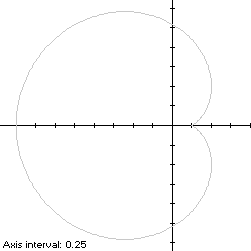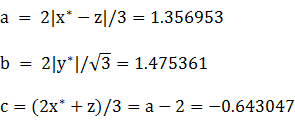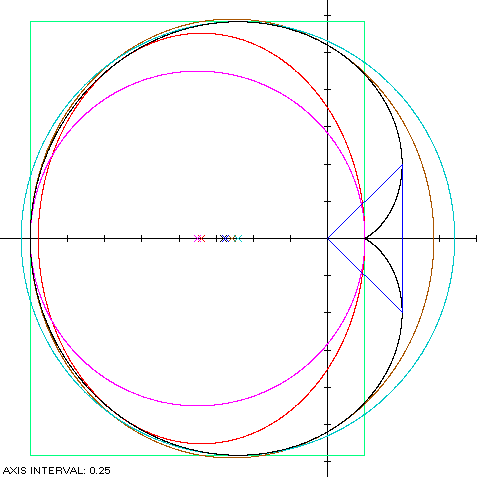Balmoral Software

Balmoral Software

r(t) = -2cos3(t/3), -π ≤ t < πFor a simple curve describing the outer envelope of the Cayley sextic, T is restricted to the interval [-π,π]. The scaling factor -2 is used for comparison with the cardioid. Since r(t) is an even function of t, the Cayley sextic is symmetric with respect to the x-axis.
The curve is traced out in a counterclockwise direction, starting from the cusp
(1/4,0) at  when
when

r'(t) = 2sin(t/3)cos2(t/3),so by (L2), the perimeter of this portion of the Cayley sextic is
By (A2), the corresponding area is
By (C2), the centroid abscissa of this portion of the Cayley sextic is
The bounding rectangle for inconics is delimited by the cusp at (1/4,0).
which is about 2% shorter than that of the Cayley sextic portion.
The line segment of the convex hull creates an isosceles triangle with the
origin, having area
By (C2), the associated centroid abscissa is
The convex hull component metrics can be summarized as follows:
The area of the convex hull is about 1% larger than that of the Cayley sextic. The centroid abscissa of the convex hull is the weighted average
Region Area Centroid abscissa Product Triangle 1/4 1/3 1/12 Remainder A1 = (15π + 44)/16 -(315π + 1016)/(480A1) -(315π + 1016)/480 Total 15π/16 + 3 -(315π + 976)/480
d/dt [x(t) - z]y(t) = d/dt 4sin(t)cos(t)cos6(t/3) + sin(t)cos3(t/3)/2has a zero at t* = -0.707452. The corresponding coordinates are
x* = -1.39729We then havey* = 1.19484
For verification,
d/dt [x(t) - z]y(t) = d/dt 4sin(t)cos6(t/3)cos(t) - 4sin(t)cos3(t/3)has a zero at t* = -1.598518. The corresponding coordinates are
x* = 0.035429We then havey* = 1.2777
For verification,
 and center abscissa
and center abscissa
 For verification,
For verification,
Figure Parameters Perimeter Area Centroid Incircle R = 9/8 7.068584 3.976078 (-0.875,0) Inellipse a = 1.098193
b = 1.3796827.809609 4.760006 (-0.848193,0) Cayley sextic 8.881262 5.875548 (-0.702073,0) Convex hull 8.712389 5.945243 (-0.688787,0) Circumellipse a = 1.356954
b = 1.4753618.901868 6.289459 (-0.643046,0) Circumcircle R = 9.155272 6.670104 (-0.603553,0)


The Cayley sextic (red) is a member of a group of similarly-shaped figures described on these pages, including (inside to outside) the rotated lima bean curve, the cardioid and the cochleoid:
Copyright © 2021 Balmoral Software (http://www.balmoralsoftware.com). All rights reserved.